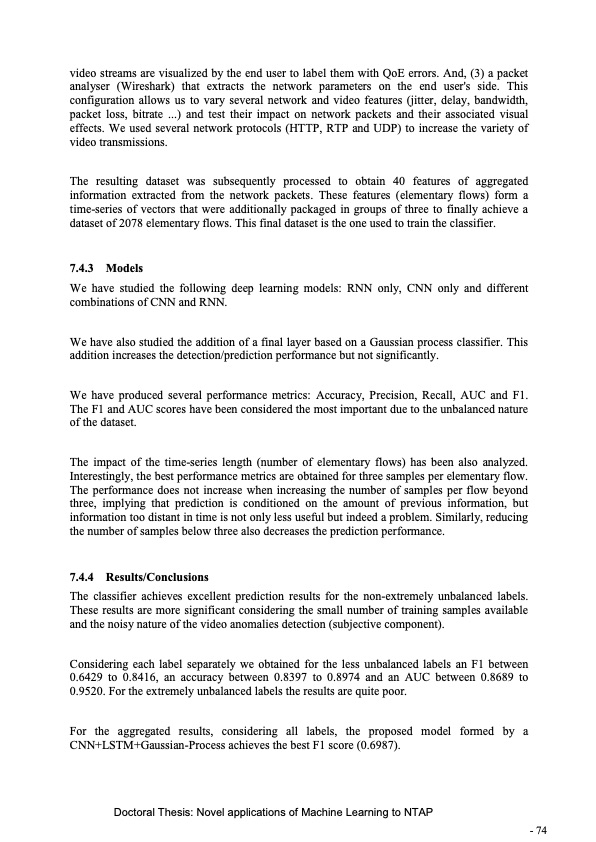
PDF Publication Title:
Text from PDF Page: 076
video streams are visualized by the end user to label them with QoE errors. And, (3) a packet analyser (Wireshark) that extracts the network parameters on the end user's side. This configuration allows us to vary several network and video features (jitter, delay, bandwidth, packet loss, bitrate ...) and test their impact on network packets and their associated visual effects. We used several network protocols (HTTP, RTP and UDP) to increase the variety of video transmissions. The resulting dataset was subsequently processed to obtain 40 features of aggregated information extracted from the network packets. These features (elementary flows) form a time-series of vectors that were additionally packaged in groups of three to finally achieve a dataset of 2078 elementary flows. This final dataset is the one used to train the classifier. 7.4.3 Models We have studied the following deep learning models: RNN only, CNN only and different combinations of CNN and RNN. We have also studied the addition of a final layer based on a Gaussian process classifier. This addition increases the detection/prediction performance but not significantly. We have produced several performance metrics: Accuracy, Precision, Recall, AUC and F1. The F1 and AUC scores have been considered the most important due to the unbalanced nature of the dataset. The impact of the time-series length (number of elementary flows) has been also analyzed. Interestingly, the best performance metrics are obtained for three samples per elementary flow. The performance does not increase when increasing the number of samples per flow beyond three, implying that prediction is conditioned on the amount of previous information, but information too distant in time is not only less useful but indeed a problem. Similarly, reducing the number of samples below three also decreases the prediction performance. 7.4.4 Results/Conclusions The classifier achieves excellent prediction results for the non-extremely unbalanced labels. These results are more significant considering the small number of training samples available and the noisy nature of the video anomalies detection (subjective component). Considering each label separately we obtained for the less unbalanced labels an F1 between 0.6429 to 0.8416, an accuracy between 0.8397 to 0.8974 and an AUC between 0.8689 to 0.9520. For the extremely unbalanced labels the results are quite poor. For the aggregated results, considering all labels, the proposed model formed by a CNN+LSTM+Gaussian-Process achieves the best F1 score (0.6987). Doctoral Thesis: Novel applications of Machine Learning to NTAP - 74PDF Image | Novel applications of Machine Learning to Network Traffic Analysis

PDF Search Title:
Novel applications of Machine Learning to Network Traffic AnalysisOriginal File Name Searched:
456453_1175348.pdfDIY PDF Search: Google It | Yahoo | Bing
Cruise Ship Reviews | Luxury Resort | Jet | Yacht | and Travel Tech More Info
Cruising Review Topics and Articles More Info
Software based on Filemaker for the travel industry More Info
The Burgenstock Resort: Reviews on CruisingReview website... More Info
Resort Reviews: World Class resorts... More Info
The Riffelalp Resort: Reviews on CruisingReview website... More Info
| CONTACT TEL: 608-238-6001 Email: greg@cruisingreview.com | RSS | AMP |